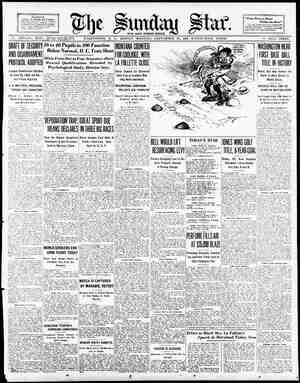Evening Star Newspaper, September 28, 1924, Page 52
You have reached the hourly page view limit. Unlock higher limit to our entire archive!
Subscribers enjoy higher page view limit, downloads, and exclusive features.
6 THE SUNDAY STAR, WASHINGTON, D. €., SEPTEMBER 28, 1924—PART 3. 2! RS anfl Vigorous Protest Is Voired ‘[!)0\‘.N’I‘HICROAI)—'l'lu-l’rnallyuf Politencss. Against Proposed Auto Law [ i s Development of “Cracking” Held Solution of “Gas” Problem Scientist Declares, Under Efficient Con- ditions Gallon of Gasoline Should Drive “Flivver” for 150 Miles. —By BECK HAVING TO REFRAIN FROM . CHASTISING THE DESTRUCTIVE CHILDREN OF YOUR GUEST— [ Authority to Impound and Confiscate Cars ()Iwrl';mi by Reckless Privers. Denouneed as njust and Absurd. BY WILLIAM [ LEMAN Two Test Methods, What the Law Provides | this amoun Four Wavs of Betterment T - = { It/ 7 ((\‘ \/%///N%\ / (7l . Z =3 Medetri v . ) ( e I ! o W e M = e anrienriss CLEAN AUTO TAGS, IN PLAIN VIEW |5 e ST S NOW DEMANDED IN MARYLAND | Sl e e 23, ' ton to aid him in the drive | There are hundreds of automobiles - 2 " | whose license tags are obecured bs o Baughman Launches Drive and Promises “Arrests vumpers ortre Garriers.: Co ; , 39 - 2 | Baughman _said. View of Paychulagist ; by Wholesale”—W arning to e the situation. section of the moto; learly states that it is [the law to have swingir * of his office who are|markers o 0 make arrests will be|that all mar posed drive, Commis- District Owners. An Instance Is Cited ur cialiv removed “FOR THE PEOPLE and POSTERITY” In uniting, under one management, five independent and self-contained lumber industries, the Ford Motor Company has revolutionized the handling of wood for automobile bodies. Logging, sawmill operation, drying wood in kilns, body parts fabrication and wood distillation have been joined in a pro- gram of efficiency and economy that is without precedent. To supply lumber requirements of over a million board feet a day, the company has acquired 450,000 acres of stand- ing timber in Northern Michigan. To assist reforestation for the coming generation, no trees under twelve inches in di- ameter are cut. Accumulated brush is burned to prevent forest fires. This allows the remaining standing timber to speed its most productive growth. Sawmills have been established near the lumber tracts, body parts being cut directly from the logs. A giant battery of dry kilns—52 units, each 222 by 20 feet—then seasons the parts for body building. Three body parts mills have already been built adjoining the kilns and here the final operations are performed. The lumber which cannot be utilized—scraps, chips and shavings—is fed into the wood distillation plant, the most modern of its kind. Thirty-four valuable by-products are recovered from the 350 tons of scrap distilled daily. An intensive program of timber conservation is maintained and the quality of parts rigidly protected. Hardwood is used exclusively. Ford body parts are not surpassed in material or in excellence of workmanship in any field of body construction. The multiple waste necessary under the previously accepted practice of cutting the logs into boards, shipping the boards to various mills and burning the resulting high percentage of scrap as fuel, is largely eliminated. Lumber, labor, time and by-products are saved. Such vital economies, combined with others at every step of the complete manufacture of Ford products, are passed directly to the public in lowered motoring costs. T e Tl Mwmmfizzldmmmmqm&ahmwfim N ,m«‘ th-,xjht’mwwfifial% > N 4.000

